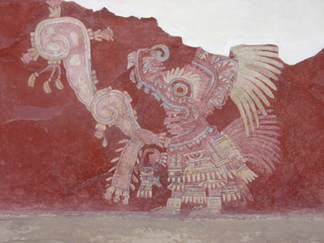 For centuries, colorful ancient murals
have remained hidden inside Mexican temples where they were preserved from the
elements. Now, working together with geophysicists, archaeologists are using
the record of Earth’s magnetic field, fixed in the red pigments of those
murals, to build a historical timeline for Mesoamerica — a region in central
and southern Mexico, Guatemala, Belize and El Salvador where civilization began
developing in 2500 B.C.
For centuries, colorful ancient murals
have remained hidden inside Mexican temples where they were preserved from the
elements. Now, working together with geophysicists, archaeologists are using
the record of Earth’s magnetic field, fixed in the red pigments of those
murals, to build a historical timeline for Mesoamerica — a region in central
and southern Mexico, Guatemala, Belize and El Salvador where civilization began
developing in 2500 B.C. A record of Earth’s magnetic field is fixed in the pigments of Mesoamerican murals like this one. Courtesy of Giacomo Chiari.
While archaeologists have been able to establish relative chronology in some of the region, an absolute chronology, such as exists for Europe, has remained elusive. “There is not yet a consensus on the absolute, that is, calendric, dates for different cultural periods in Mesoamerican archaeology,” says Rob Sternberg, a geophysicist at Franklin & Marshall College in Lancaster, Penn., who studies archaeomagnetic dating. “This is an important cultural region, so any dating method that can contribute is helpful.”
That is why Avto Goguitchaichvili and colleagues from the National University of Mexico, the University of Torino, Italy, and the Getty Conservation Institute set out to establish the magnetic signature of four murals painted at three different locations during the archaeological periods known as the Classic and early post-Classic (about A.D. 200 to 1200). Analyzing samples of pigments containing iron minerals from the murals gave the researchers a snapshot of the magnetic field in the region at that time, as reported in the June 22 Geophysical Research Letters.
When the mural paint was still wet, iron oxide grains in the pigments were free to move about, aligning with the magnetic field of the time. When the paint dried, the magnetic field direction, inclination and declination became fixed — leaving a “remanent magnetization,” similar to that formed in igneous rocks as they cool and harden from lava or magma. Goguitchaichvili and co-workers say that, by calibrating the dates and magnetic direction of murals that have not moved since they were painted, remanent magnetization can also help establish an overall timeline for the region.
“The idea is to take some paintings that are well-dated and measure the magnetic field,” says co-author Giacomo Chiari, chief scientist of the Getty Conservation Institute in Los Angeles, Calif., who developed the method with Roberto Lanza at Torino. “If you do that many, many times and those points are in good agreement with each other, you can build up a calibration curve.” Scientists can then apply such a calibration curve to date other archaeological objects that contain magnetic minerals, such as clay-rich hearths and kilns.
The research team chose the murals, Templo de Venus at Cacaxtla, Chapulines and Estrellas at Cholula and Templo Rojo at Tenochtitlan, for their well-preserved abundance of red pigment, which made them likely candidates to contain the magnetic iron oxide minerals hematite and magnetite. Using X-ray diffraction and routine paleomagnetic techniques, the team found that the murals did contain abundant hematite and a more minor component, magnetite. The remanent magnetization, however, was due mostly to the magnetite. When researchers compared the magnetic directions of the murals to directions measured in volcanic rocks dated to the same periods and to other archaeomagnetic studies of similarly aged lime-plasters, they found rough agreement. And based on that agreement, they conjecture that the mean direction from three of the murals corresponds to the interval between A.D. 1000 and 1200.
Sternberg, however, says that he remains unconvinced of the strength of the findings, pointing to the wide range of estimated ages of the murals. “This is a large time span, so we can’t know if the archaeomagnetic directions for the different murals should be the same as each other, or know what age they should date to,” he says. “So this is a poorly controlled experiment.”
Although the authors say that more work is necessary, they write that their findings open “new alternatives for improving the Mesoamerican absolute chronology.”

